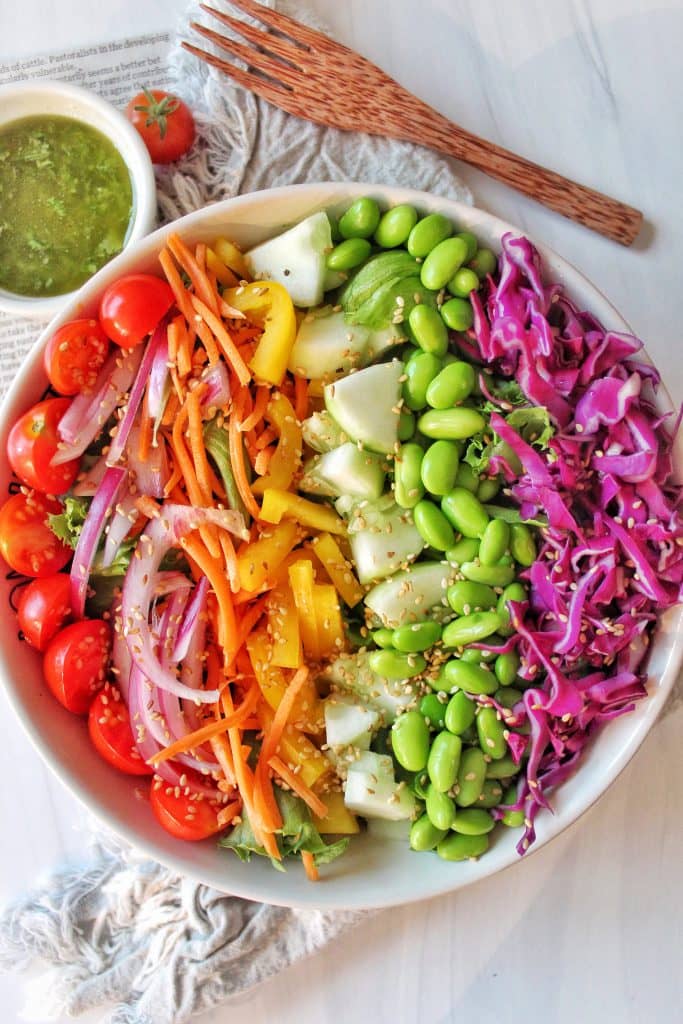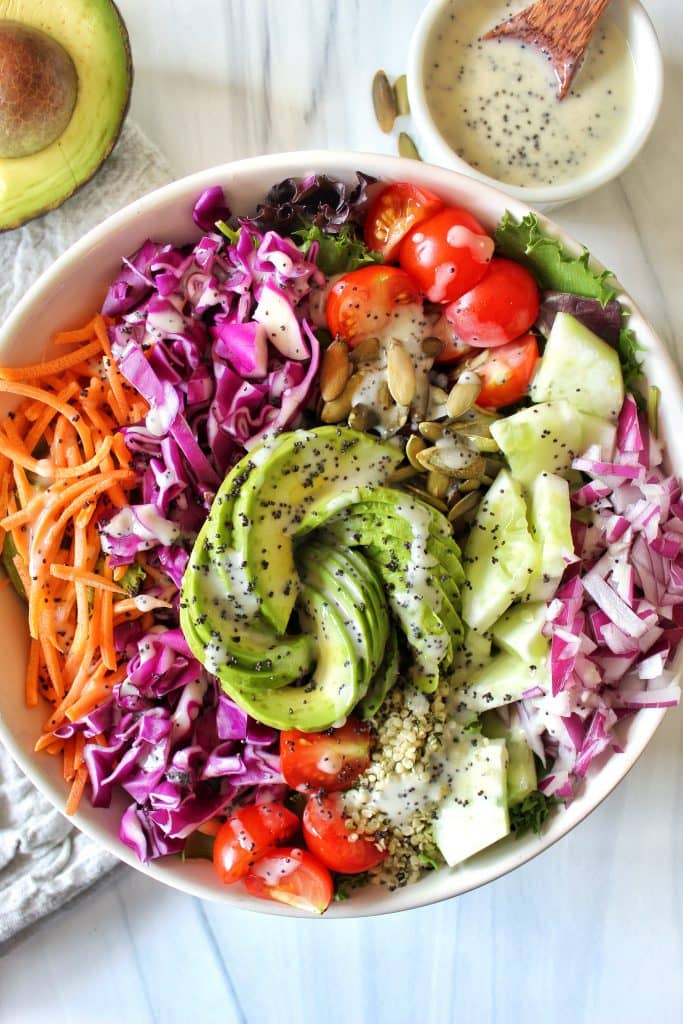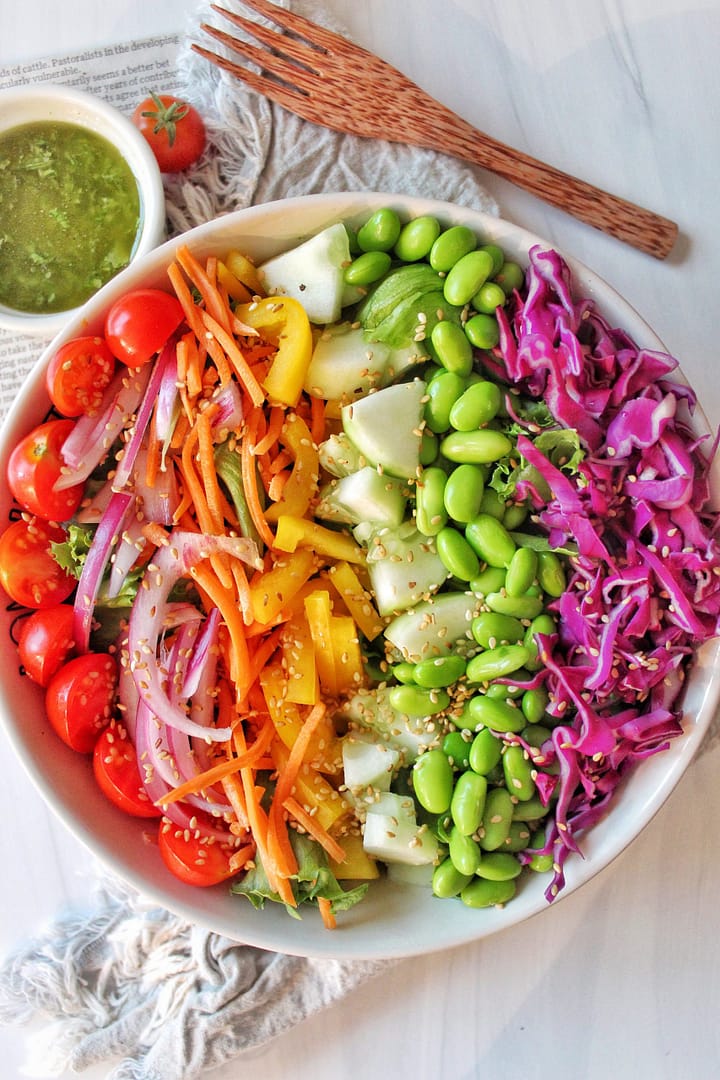Dishing out the scoop on how to build a balanced salad by exploring the DOs and DONTs, a guide to macronutrients, and a build-your-own chart to help you keep your salads fresh, filling and fun.

I know what some of you must be thinking: why the heck do we need a blog post on building a salad?
A salad can be a powerful meal that can be fresh, filling and fun … when it’s created properly. I hear so often from people that they get hungry after an hour, they aren’t losing weight, they don’t feel full enough or satisfied enough, salads are boring, etc. Why is this? Typically, because the salad hasn’t been proportionally crafted.
Every meal is an opportunity to nourish your body, regardless of your goals (stay healthy, lose weight, build muscle) and in order to serve you properly, your meals must be balanced with the right combination of carbs, proteins, and healthy fats. The properportions of these three macronutrients are going to help you feel fuller, feel satisfied, and help you enjoy your salad even more so that you’re not overeating later, binge snacking or ditching your salads completely.
In this blog post, I’ll cover some DOs and DONTs for building salads, I’ll highlight some common things that people do to sabotage their salads, and I’ll introduce you to my build-your-own guide that you can use to create all kinds of salad combinations.

When I look at building a proportionally crafted salad, I’m considering the three macronutrients (carbs, protein and healthy fats) and the right combination that is going to keep me full and happy.
When I build my salads, the rough estimate of each macronutrient is:
1. 60 -70% carbs
2. 20 – 30% protein
3. 10 – 20% healthy fats
DON’T overthink these proportions and don’t feel like you have to measure to the exact percentage point. Just be mindful when you’re eyeing the ingredients for your salad and do a rough eyeball estimate. Also keep in mind that food is not one dimensional – it can have both carbs and protein. For example, black beans are a source for both carbohydrates and protein.
Not to get too deep into the nitty gritty details but the difference lies in the type of carbs you are considering:
1. simple carbs (fruit)
2. starchy carbs (beans, grains, root vegetables)
3. fibrous carbs (most other vegetables)
Don’t overstress this either. As long as you’re eating fruits, vegetables, legumes and whole grains, you’re in a great position for healthy eating.
Now that you have a general idea of a balanced macronutrient profile and the types of carbs, let’s discuss the DOs and DONTs of building a salad.

The DOs
1. DO select leafy greens as your base. These are low in calorie, incredibly rich in fiber, and micronutrients.
2. DO add other vegetables to your salad to give yourself some variation, flavor, texture and additional varied sources of nutrients.
3. DO add a healthy source or two of protein. Don’t overdo the amount of protein. Healthy adults generally need less than they think they do and a little goes a long way towards helping keep you fuller for longer.
4. DO add some healthy fats (these also help with filling you up but more importantly, have some really positive health impacts like lowering high cholesterol and blood pressure).
5. DO add the occasional fruit to your salad but do this lightly. Our focus should be on the fibrous carbs (veggies!).
6. DO give yourself a good size portion! Many of your vegetable choices are going to be lower in calorie so you’ll need more to hit the proper caloric intake, especially if you are interested in building muscle.
7. DO choose healthy ways to dress your salad: olive oil, vinegar, lemon/lime, homemade dressings, hummus, tahini, mashed avocados.
8. DO craft a salad with flavors that you will enjoy! Healthier eating is more sustainable when you enjoy the process. If you love tomatoes, make sure to add them. If you don’t love raw onions, skip them and add a variety of other veggies.
The DON’Ts
1. DON’T sabotage your clean efforts by adding processed or junk carbohydrates to your salad (once in a great while is fine). This includes: croutons, fried onions, tortilla strips, etc.
2. DON’T sabotage your salad by adding junk protein: bacon bits, sliced deli meats, etc. Processed meats are classified as carcinogens and are overall terrrible for good health.
3. DON’T sabotage your salad by adding unhealthy fats: most dressings, most cheeses (usually they’re 70% saturated fat which is not good for overall health)
-Dressings usually contain refined sugars, processed oils, saturated fats, and yucky preservatives and fillers.
4. DON’T create a small salad with only 3 ingredients. Portion matters here, especially in helping to keep you full for longer than a couple of hours and plant diversity is important in helping you get a wide range of micronutrients.
Now that you have some of my basic DOs and DON’Ts for crafting a proportional and filling salad, let’s talk about the various types of vegetables, fruits, whole grains and legumes that you can use.
By selecting different options each time, you can keep salads fun and fresh (which means you’re more likely to stick to eating them!). I’ve created a build your own chart with the different food groups and various examples. This is by no means an exhaustive list but certainly a thorough enough one to get you on your way!

The base of your salad should be a very generous serving of leafy greens. Choose one or a combo of greens for more complex taste.
Next up are your veggie toppings. Between your leafy greens and veggies, that should make up about 60 -70% of your salad. There are so many veggie options! Don’t forget to switch it up and increase diversity when you craft a bowl.
Fruits are optional but can certainly provide a little extra flavor to your salad. Keep these portions small. For example, with sliced strawberries, I’m only adding 2-3 strawberries. Dried fruits should be less than an ounce as they contain less fiber and more sugar.
Legumes and grains are great ways to add healthy, filling protein to your salad so don’t forget these! One quarter cup should be more than sufficient for your protein needs. These starchy carbs go a long way towards keeping you full!
Seeds are one of my personal favorite ways to add a little crunchy topping and fun to your salad. Hemp seeds are a great source of protein. Flax seeds are a great source of Omega 3s. Pumpkin seeds are another great source of protein. I find a tablespoon of seeds sufficient.
Nuts also have health benefits but they are high in fat so we want to keep this amount to 1-2 ounces (remember your oil and any avocado also count as fats!). Avocados are also high in (healthy) fat and are a great addition to your salads – I always recommend adding avocado!
My favorite go-to dressing is a squeeze of fresh lemon with a drizzle of extra virgin olive oil. Go very light on the oils as they fill you up way faster than any other foods. We want to get full on veggies, not oils!
Spices and herbs are another fun way to add great flavor to your salads. There’s nothing like fresh mint or cilantro on a salad! Dried herbs also go a long way. Try it and let me know what you think.
No matter what your fitness or health goals are, salads can be powerful friends. When they’re crafted proportionally, are nutritionally dense and a delight to the palette, they are an effective tool in your belt. I hope you’ve gained some additional insight into making a balanced salad bowl and look forward to seeing some of your creations (don’t forget to tag us on Instagram!).
If you have any other salad tips or healthy toppings, feel free to leave us a comment below.
Cheers,
Stella






One Comment
BERNARDIN K
Tkx so much